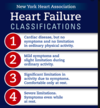[HYHO] HPS Session 1 Heart Failure Flashcards
(25 cards)
Define:
Heart Failure
Complex clinical syndrome that results from:
Structural or functional impairment of ventricular filling or ejection of blood
What are the cardinal clinical symptoms of heart failure?
Dyspnea
Fatigue
Edema
Rales
Stages of HF
Describe a Stage A patient
At RISK for HF but is asymptomatic
No limitations in ordinary physical activity

Give examples of patients that would be STAGE A of HF:
- HTN
- Atherosclerotic dz
- DM
- Obesity
- Metabolic syndrome
Stages of HF
Describe a STAGE B patient
Mild symptoms
SLIGHT limitation during ordinary activity

Give examples of patients that would be STAGE B of HF:
- Previous MI
- LV remodeling including LVH and low EF
- Asymptomatic valvular disease
Stages of HF
Describe a STAGE C patient
Structural heart disease
Significant limitation in activity due to symptoms.
Comfortable only at rest

Give examples of patients that would be STAGE C HF?
- Known structural heart disease
- Shortness of breath and fatigue
- Reduced exercise tolerance
Stages of HF
Describe a STAGE D patient
SEVERE limitations
Symptoms even while at rest

Give examples of patients that would be STAGE D HF?
Marked symptoms at rest despite maximal medical therapy
What are the two types of heart failure?
Reduced ejection fraction heart failure - Systolic
Preserved ejection fraction heart failure - Diastolic
Patients with values of ___% to ___% are classified as having borderline reduced ejection fraction
Patients with values of 41% to 49% are classified as having borderline reduced ejection fraction
What is the most common cause of heart failure with reduced ejection fraction?
Coronary artery disease
What is the most common cause of heart failure with preserved ejection fraction?
Hypertension
What is the common heart archetectural change that occurs with Heart failure with reduced ejection fraction?
Left ventricular dilation
What is the common heart archetectural change that occurs with Heart failure with preserved ejection fraction?
Left ventricular hypertrophy
Quick and dirty steps (6) on how to measure the JVP:
- Raise head to relax SCM muscles
- Raise to 30degrees, turn pts head slightly away
- Examine both sides of the neck, find internal jugular venous pulsations
- (if necessary) adjust head of bed till you can see oscillation point or meniscus of the internal jugular venous pulsations
- Focus of RIGHT internal jugular vein
- Identify the highest point of pulsation in the right jugular vein
What are the diagnostic tests you would order for a HF pt?
CBC
CMP
Cardiac enzymes
UA
Beta-natriuretic peptide
What are some imaging tools you’d order to diagnose HF?
Echocardiography w/ doppler
CXR
What is the systematic appraoch to interpreting a CXR?
ABCDE-F
A = Airway
B = Bone
C = Cardiac
D = Diaphragm
E= Extras
F = Fields of the lung
What do kerley B lines represent?
Interstitial edema
What is the measurement of 2mm for pitting edema documented as?
4mm?
6mm?
8mm?
2mm = 1+
4mm = 2+
6mm= 3+
8mm= 4+
What are examples of major criteria for HF?
- Paroxysmal nocturnal dyspnea
- Orthopnea
- Elevated JVP
What are the parasympathetic considerations you should make for OS w/ HF?
Parasympathetic will present with involvement with:
Increased tone –> bradycardia
Vagus nerve
OA, AA and C2


